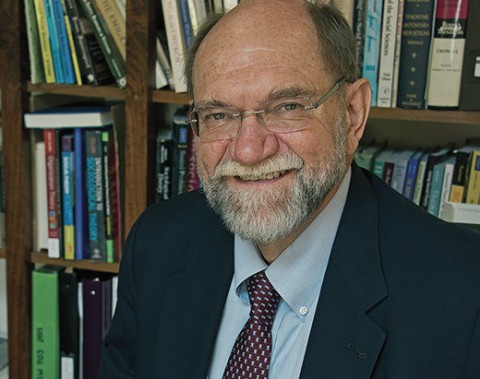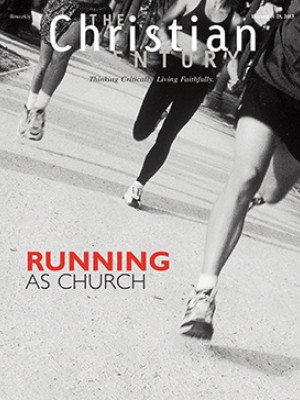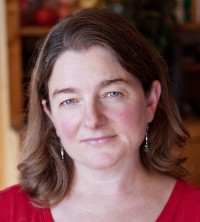Families of faith: Sociologist Vern Bengtson

Early in his career as a scholar, Vern Bengtson started the Longitudinal Study of Generations, a multidisciplinary investigation of families, aging and social change. The study has followed families since 1970. Bengtson taught sociology for many years at the University of Southern California. A past president of the Gerontological Society of America, he is coauthor of Families and Faith: How Religion Is Passed Down across Generations and How Families Still Matter: A Longitudinal Study of Youth in Two Generations, among many other works.
What did you find out about how families transmit religion from generation to generation?
We found that the highest generational transmission occurs in families with a high degree of warmth—particularly if the father is perceived as warm and close. It’s not enough for parents to be role models, send their kids to church, be involved in church and have devotional activities at home. That’s all well and good, but the key is what we call intergenerational solidarity or family cohesion.
Read our latest issue or browse back issues.
Why is fatherly warmth especially important?
I wish I knew. Generally mothers have more contact with kids; mothers are more likely to nurture and teach, pray with the kids at bedtime; fathers are more absent.
I don’t have any data to support this, but I have a hunch that there is something about religion that is male-influenced, at least in American society, such that if a father picks up on religion, the kids are going to pick up on it too. And if the father is indifferent to religion, the kids may be indifferent to religion. This is especially true in father-son relationships.
Were there other surprises in your data?
We were surprised by the importance of grandparents—and, again, especially of grandfathers. Grandparental warmth—emotional closeness—was the highest predictor of whether similarity or transmission would exist across generations.
The most frequent type of grandparental effect was when the grandparents and parents teamed up and the grandparents reinforced the parents in religious socialization. You can see that especially in three-generation Catholic, evangelical and Mormon families.
The second type of grandparental influence that we found was what we called the skipped-generation effect. That’s when the grandparents replace the parents in religious socialization.
For example, one family talked about what an influential person the grandfather had been when the parents had split up and the mother was dysfunctional. The daughter, who is now in her forties, talked about how on Sundays Grandpa would take them to church, and they would all sit together. He always had a red carnation in his lapel, and it was the same Sunday after Sunday. She said, “I felt so secure.”
How did you determine if religion transmission had taken place?
We are fortunate in that in our data we have eight or nine dimensions of religion to track—more than most studies have. Most studies just ask about church attendance and membership. In our studies we have that data plus answers to questions about religious intensity (“How religious would you say you are?”) and a set of questions on beliefs.
We looked at transmission in two ways. The first is simply similarity. We compare the answers of the children to the answers of the parents. We also look at statistical packages to determine how well the parents’ score predicts the child’s score.
Do some religious traditions transmit better than others?
Mormons, Jews and evangelical Christians have the highest rate of transmission. They have the institutional support and reinforcement outside the family that helps in passing on their religious traditions.
The best example, of course, is Mormons. For Mormons, religion and family are intertwined—they are almost one and the same. Mormons have, for example, the practice of Family Home Evening: every Monday evening every Mormon family is together. They are together in regard to faith and in regard to family. What a powerful message that is.
Evangelicals get a lot more reinforcement in family than do mainline Protestants or Catholics. Mainline Protestant, Catholic and Eastern Orthodox traditions put much more emphasis on ritual, but not specifically on ritual about the family. The family is assumed in these traditions, but it is not the focus.
It is almost impossible not to become a Mormon if you are raised in a Mormon family. It is very difficult not to become an evangelical if you are raised in an evangelical family.
Mainline Protestants have been scratching their heads over the precipitous drop in membership and attendance. One wise minister whom I interviewed noted that mainline Protestants want people to think for themselves. “In our tradition, religious shopping is a sign of an active spiritual life. Religious conformity is not a sign of an active spiritual life.”
Are there religious differences between millennials and their parents?
Yes and no. Both Wade Clark Roof and Robert Wuthnow studied various generations and argued that a specific generation had an enormous effect on change. I do not find their data convincing at all. I see more similarities than differences between the generations.
One of the most remarkable discoveries in these data is that the degree of religious influence across generations has not changed much since the ’60s and ’70s, despite the forces in culture that indicate they should have changed: increasing secularization with decreasing church attendance.
With the rise of religious nones among the young and more single-parent families, one would think we would see reduced intergenerational influence. But it has not declined. Parents and grandparents influence their children in much the same way as they did in the 1970s.
One of the important findings of our study is about where that fast-growing category of religious nones comes from. Traditional wisdom and past research have suggested that those who have no religion are rebels from religious backgrounds and that they have no religious affiliation because the religion of their youth was too rigid.
But that is not where the nones are coming from. They are coming from families of nonreligious people. There is an intergenerational transmission of nonreligion that functions very much like the transmission of religion.
Do you look to see if the children of Lutherans, for example, remain Lutheran?
I don’t make very much of continuity in that respect, because religious denominations have changed so much over the past 35 years. Measuring denominational affiliation is not as significant as measuring self-rated religious intensity.
I am convinced that religiosity or religious intensity is a driving force that is more salient than belief, in the sense of adhering to a creed. Agreement with specific statements of belief is the least likely religious trait to be passed on.
So by religious transmission you don’t necessarily mean that the children assent to the same statements of belief that their parents do? You think that is the wrong thing to be looking for?
That’s right. But unfortunately, I don’t have good data on that because I have only a few items in my study on belief, and they are dated. If you give the statement I wrote in 1970, “God exists in the form that the Bible describes him,” to a 19-year-old today, he is going to ask, “What does that mean?” The statement is not expressed in the vocabulary that a kid would find terribly meaningful.
So I don’t know what it means to get a 50 percent agreement between parents and children on that item. Does it mean they believe the same thing in terms of a theism described in a text? I don’t know. I am skeptical of my methods.
How did you begin studying the transmission of religion across generations?
It started out to be a study of three-generation families and aging. I wanted to see how different ages within a family interacted and the effect of that on mental and physical health. But the study became the longest longitudinal study of families in existence. I followed 350 families for 50 years.
The question has a personal side as well. I grew up in a very religious family. My relatives in the 19th century were leaders of a pietistic church movement in Sweden. When they immigrated to this country, they brought their fervent evangelical faith with them. My father had nine brothers and sisters, two of whom became ministers, all of whom were fervent evangelicals. I had 33 first cousins on that side. Every one of them was and still is, to my knowledge, a fervent evangelical. I grew up in a household of true believing, born-again Christians.
Then I went off to the University of Chicago. I was amazed to discover that my classmates did not come from the same religious background that I did. And so I wondered: Why is my family so different from others? What accounts for this astounding religious conformity?
Over time, I moved away from the religion of my family. This caused them an enormous amount of distress.
But a few years ago, after I retired from my position at USC, one Easter Sunday I got up and said, “Gee, I think I will go to church.” I’d seen this beautiful Gothic church in downtown Santa Barbara. It was an Episcopal church. I walked in the door. The service had already started; the congregation was singing, the organ was soaring, and the stained glass was filtering this godly light. I was overwhelmed. I felt like Saul on the road to Tarsus. I had a religious experience. I was just like C. S. Lewis put it: surprised by joy. I joined the choir, and here I am in church again.
So my mom and dad are sitting up in heaven, chuckling and saying, “Well, the prodigal has returned.” The Episcopal Church is very different in ritual and in theology from the evangelical tradition of my family. But the point is that this intergenerational transmission business follows us all through our lives.






